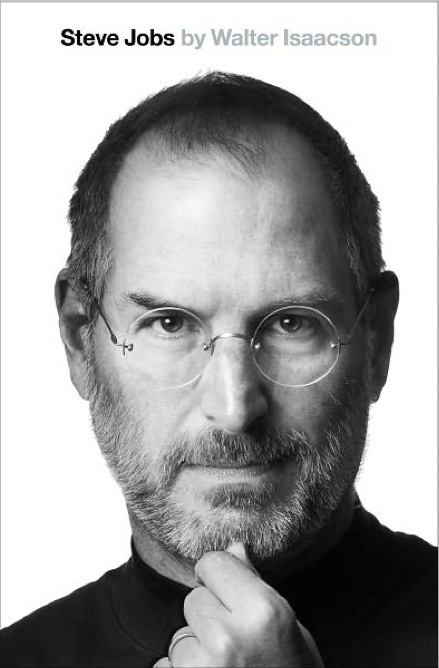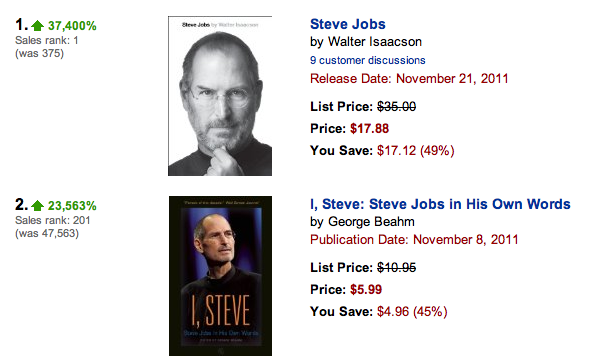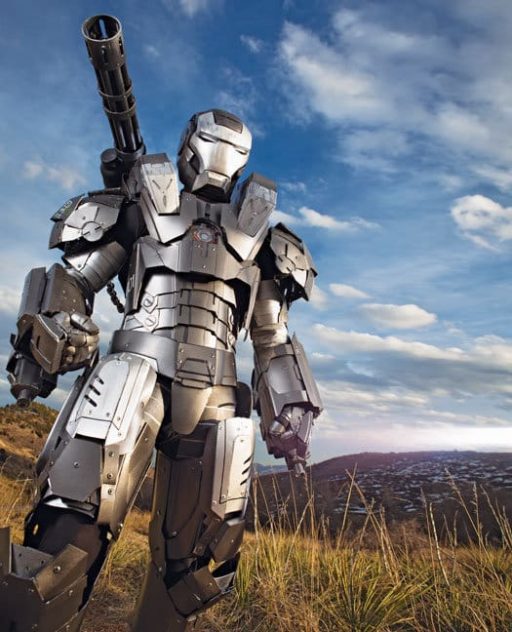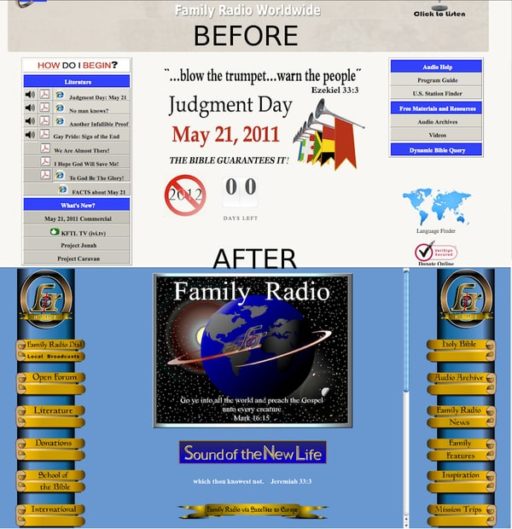Simon & Schuster has bumped up the release of Walter Isaacson’s authorized biography of Steve Jobs to October 24th and the book had previously been scheduled to be released on November 21st. Time Magazine has cancelled its previously scheduled print run this week in order to put together a retrospective issue on Steve Jobs and the book was fully authorized by Steve Jobs and is based on over 40 interviews with Jobs and interviews with over 100 of his friends and family members. The book has seen a massive increase in demand since yesterday, registering as the #1 selling book at Amazon with a sales gain on the order of 40,000% over the past 24 hours and the book was still being updated in late August to reflect Jobs’ resignation as Apple’s CEO, will include full details on his life…………….
Simon & Schuster has moved up the publication of the first authorized biography of Steve Jobs, which previously scheduled for release Nov. 21, Steve Jobs will now debut Oct. 24 and pre-orders have pushed the book to the No. 1 spot on Amazon‘s bestseller list. Pre-orders for Steve Jobs’ biography have skyrocketed 41,800% and the Steve Jobs biography by Walter Isaacson is available to pre-order here for $17.88. The book is based on more than forty interviews with Steve Jobs over a period of two years, which is what sets it apart from other biographies of the Apple CEO and the interviews with Jobs, the author Walter Isaacson has also spoken to more than a hundred of Jobs‘ relatives, friends, colleagues and competitors. All of this information is packed into 448 pages, available as a hardcover for $20.40 and Nook eBook for $14.99 and the cover of the book, featuring just an image and a few words in Helvetica, looks just like an Apple product. In below you will find amazon.com’s description of Steve Jobs Biography:
Based on more than forty interviews with Jobs conducted over two years-as well as interviews with more than a hundred family members, friends, adversaries, competitors, and colleagues-Walter Isaacson has written a riveting story of the roller-coaster life and searingly intense personality of a creative entrepreneur whose passion for perfection and ferocious drive revolutionized six industries: personal computers, animated movies, music, phones, tablet computing, and digital publishing.
At a time when America is seeking ways to sustain its innovative edge, and when societies around the world are trying to build digital-age economies, Jobs stands as the ultimate icon of inventiveness and applied imagination. He knew that the best way to create value in the twenty-first century was to connect creativity with technology. He built a company where leaps of the imagination were combined with remarkable feats of engineering.
Although Jobs cooperated with this book, he asked for no control over what was written nor even the right to read it before it was published. He put nothing off-limits. He encouraged the people he knew to speak honestly. And Jobs speaks candidly, sometimes brutally so, about the people he worked with and competed against. His friends, foes, and colleagues provide an unvarnished view of the passions, perfectionism, obsessions, artistry, devilry, and compulsion for control that shaped his approach to business and the innovative products that resulted.
Driven by demons, Jobs could drive those around him to fury and despair. But his personality and products were interrelated, just as Apple’s hardware and software tended to be, as if part of an integrated system. His tale is instructive and cautionary, filled with lessons about innovation, character, leadership, and values.
TIME releases a special commemorative issue on Steve Jobs to hit newsstands and tablet devices and to produce this special issue, TIME stopped the presses on its previously planned issue in order to devote its cover and 21 pages of the full issue to Jobs’ life and career. The issue includes a six-page essay by Jobs’ biographer Walter Isaacson, a historical report on Jobs career by TIME technology reporters Harry McCracken and Lev Grossman and a photo essay by Diana Walker, who has been shooting Jobs for TIME since 1982. The cover image is a photograph of Jobs taken by Norman Seeff in 1984. The magazine is increasing its print run for this special issue, which will be available worldwide. Excerpt of Isaacson’s Essay below:
Jobs thus became the greatest business executive of our era, the one most certain to be remembered a century from now. History will place him in the pantheon right next to Thomas Edison and Henry Ford. More than anyone else of his time, he made products that were completely innovative, combining the beauty of poetry and the power of processors. With a ferocity that could make working with him as unsettling as it was inspiring, he also built what became, at least for a period this past month, the world’s most valuable company. And he was able to infuse into its genetic code the design sensibilities, perfectionism and imagination that make it likely to be, even decades from now, the company that thrives best at the intersection of artistry and technology.
In the early summer of 2004, I got a phone call from him. He had been scattershot friendly to me over the years, with occasional bursts of intensity, especially when he was launching a new product that he wanted on the cover of Time or featured on CNN, places where I’d worked. But now that I was no longer at either of those places, I hadn’t heard from him much. We talked a bit about the Aspen Institute, which I had recently joined, and I invited him to speak at our summer campus in Colorado. He’d be happy to come, he said, but not to be onstage. He wanted, instead, to take a walk so we could talk.
That seemed a bit odd. I didn’t yet know that taking a long walk was his preferred way to have a serious conversation. It turned out that he wanted me to write a biography of him. I had recently published one on Benjamin Franklin and was writing one about Albert Einstein, and my initial reaction was to wonder, half jokingly, whether he saw himself as the natural successor in that sequence. Because I assumed that he was still in the middle of an oscillating career that had many more ups and downs left, I demurred. Not now, I said. Maybe in a decade or two, when you retire.
But I later realized that he had called me just before he was going to be operated on for cancer for the first time. As I watched him battle that disease, with an awesome intensity combined with an astonishing emotional romanticism, I came to find him deeply compelling, and I realized how much his personality was ingrained in the products he created. His passions, demons, desires, artistry, devilry and obsession for control were integrally connected to his approach to business, so I decided to try to write his tale as a case study in creativity.
[ttjad keyword=”general”]





